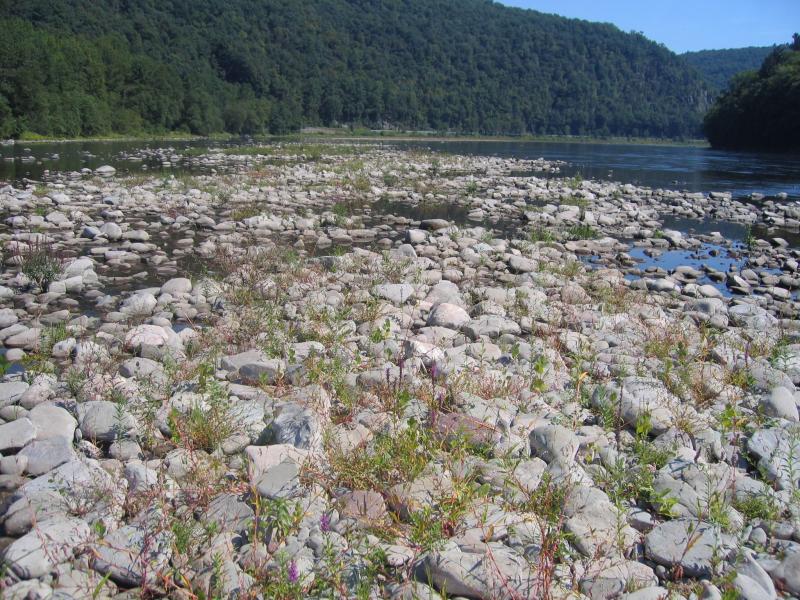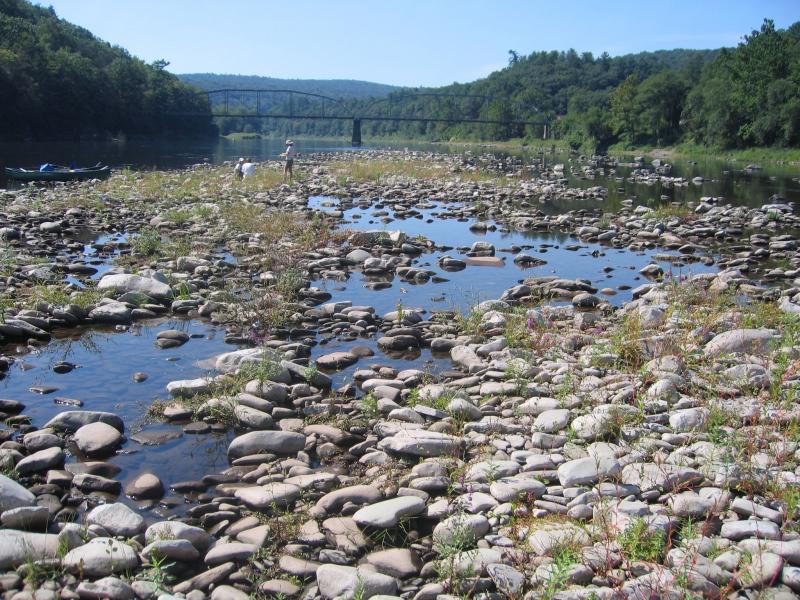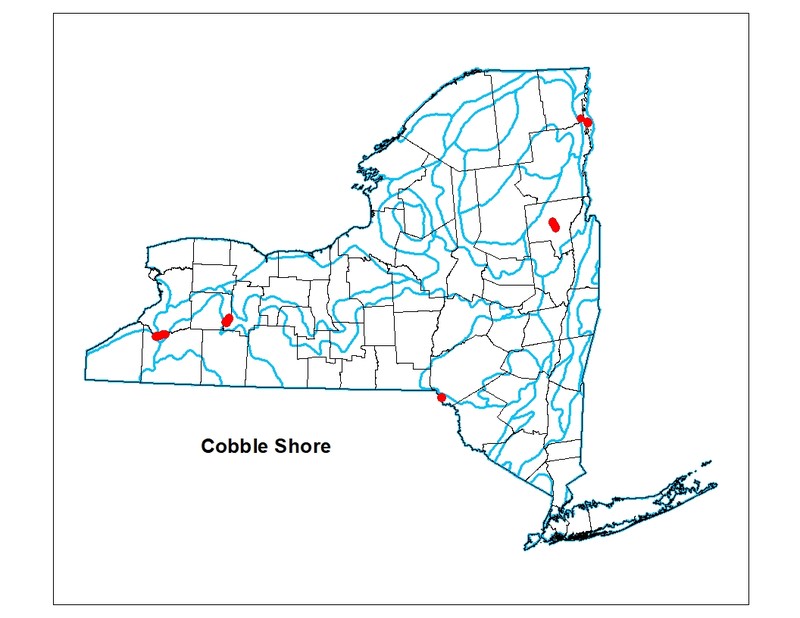Cobble Shore
- System
- Terrestrial
- Subsystem
- Open Uplands
- State Protection
- Not Listed
Not listed or protected by New York State.
- Federal Protection
- Not Listed
- State Conservation Status Rank
- S4
Apparently Secure in New York - Uncommon in New York but not rare; usually widespread, but may be rare in some parts of the state; possibly some cause for long-term concern due to declines or other factors.
- Global Conservation Status Rank
- G4G5
Apparently or Demonstrably Secure globally - Uncommon to common in the world, but not rare; usually widespread, but may be rare in some parts of its range; possibly some cause for long-term concern due to declines or other factors. More information is needed to assign either G4 or G5.
Summary
Did you know?
Cobble shore communities associated with rivers and streams are particularly dynamic, as they are subject to the seasonal influences of ice scour and flooding. This community type includes both "active" and "stable" cobble shores. Active shores are sites where cobble is loose, moved frequently due to wave and current action. This type of cobble shore is particularly influenced by seasonal hydrologic changes. Stable cobble shores are more densely vegetated with grasses and forbs, but are still subject to periodic disturbance. For this reason, invasive species such Japanese knotweed (Reynoutria japonica var. japonica) and purple loosestrife (Lythrum salicaria) have become extremely abundant at some sites.
State Ranking Justification
There are a couple thousand occurrences statewide. A few documented occurrences have good viability and several are protected on public land or private conservation land. This community is limited to the water bodies with cobble shores in the state, and there are only a few high quality examples. The current trend of this community is probably stable for occurrences on public land, or declining slightly elsewhere due to moderate threats that include alteration to hydrology, shoreline development, instream gravel mining, and invasive species.
Short-term Trends
The number and acreage of cobble shores in New York have probably declined slightly in recent decades as a result of shoreline development, alteration to the hydrology, instream gravel mining, and invasive species.
Long-term Trends
The number and acreage of cobble shores in New York have probably declined moderately from historical numbers likely correlated to the alteration of natural hydrology from impoundments, shoreline hardening, and instream gravel mining.
Conservation and Management
Threats
Cobble shores are threatened by development (e.g., residential, agricultural, industrial) in the surrounding landscape. Structures built along the shoreline (e.g., riprap, boat launches) are a particular threat to this community. Other threats include habitat alteration (e.g., instream gravel mining, road crossings, logging in adjacent floodplain), and relatively minor recreational overuse (e.g., boating, ATVs, trampling by visitors, fishing, trash dumping). Threats to adjacent lakes and rivers may apply to the cobble shore (e.g., pollution, nutrient loading, sedimentation, impoundments and flooding, water release for rafting). Several cobble shores are threatened by invasive species, such as purple loosestrife (Lythrum salicaria), reed canary grass (Phalaris arundinacea), reedgrass (Phragmites australis ssp. australis), and Japanese knotweed (Reynoutria japonica var. japonica).
Conservation Strategies and Management Practices
Where practical, establish and maintain a natural riparian buffer to reduce storm-water, pollution, and nutrient run-off, while simultaneously capturing sediments before they reach the cobble shore. Avoid habitat alteration along the shoreline and surrounding landscape. Restore cobble shores that have been affected by unnatural disturbance (e.g., remove obsolete impoundments in order to restore the natural hydrology). Reduce or eliminate instream gravel mining from the best examples of cobble shore. Prevent the spread of invasive exotic species into the cobble shore through appropriate direct management, and by minimizing potential dispersal corridors, such as roads and bridges. Maintain or restore the natural flood and ice scour regime.
Development and Mitigation Considerations
Where practical, establish and maintain a natural riparian buffer to filter storm-water, pollution, and nutrient run-off from surrounding uplands and to capture sediments before they reach the cobble shore. Avoid habitat alteration along the shoreline and in surrounding landscape. Minimize potential dispersal corridors for exotic species, such as roads and bridges. Maintain or restore the natural flood and ice scour regime.
Inventory Needs
Survey for occurrences statewide to advance documentation and classification of cobble shore. Continue searching for large sites in excellent to good condition (A- to AB-ranked).
Research Needs
Research the composition of cobble shores statewide in order to characterize variations (e.g., river vs. lake shorelines) and to clearly separate this community from cobble shore wet meadow and riverside sand/gravel bar. Collect sufficient plot data to support the recognition of several distinct cobble shore types based on composition, cobble type, and by ecoregion.
Rare Species
- Carex buxbaumii (Brown Bog Sedge) (guide)
- Carex crawei (Crawe's Sedge) (guide)
- Carex emoryi (Emory's Sedge) (guide)
- Cicindela ancocisconensis (Appalachian Tiger Beetle) (guide)
- Cicindela marginipennis (Cobblestone Tiger Beetle) (guide)
- Gentianopsis virgata (Lesser Fringed Gentian) (guide)
- Lysimachia quadriflora (Linear-leaved Loosestrife) (guide)
- Ophiogomphus anomalus (Extra-striped Snaketail) (guide)
- Ophiogomphus aspersus (Brook Snaketail) (guide)
- Phanogomphus quadricolor (Rapids Clubtail) (guide)
- Polygonum buxiforme (American Knotweed) (guide)
- Potentilla supina ssp. paradoxa (Bushy Cinquefoil) (guide)
- Prunus pumila var. depressa (Dwarf Cherry) (guide)
- Ptelea trifoliata ssp. trifoliata (Wafer-ash) (guide)
- Trichophorum clintonii (Clinton's Club Sedge) (guide)
Range
New York State Distribution
Cobble shores are widespread throughout upstate New York, north of the North Atlantic Coast Ecoregion. Extensive lakeside cobble shores are predicted along Lake Champlain, especially in the northern part of the lake. Large riverside occurrences may be uncommon in the state.
Global Distribution
This physically broadly-defined community may be worldwide. Examples with the greatest biotic affinities to New York occurrences are suspected to span north to southern Canada, west to Minnesota, southwest to Indiana and Tennessee, southeast to Georgia, and northeast to Nova Scotia.
Best Places to See
- Letchworth State Park (Livingston County)
- Upper Delaware Scenic and Recreational River
- South of The Glen (Warren County)
- Zoar Valley Multiple Use Area
Identification Comments
General Description
A community that occurs on the well-drained cobble shores of lakes and streams. These shores are usually associated with high-energy waters (such as high-gradient streams), and they are likely to be scoured by floods or winter ice floes. This community includes both active and stable shores. Active cobble shores have loose cobbles that are moved by waves or river currents; these shores are sparsely vegetated, and they have comparatively few species. Stable cobble shores have cobbles embedded in sand or peat, usually with vegetation rooted between the cobbles, and are generally more diverse than active cobble shores.
Characters Most Useful for Identification
Cobble shores can be found along streams throughout upstate New York, north of Long Island. The community occurs on well-drained cobble, rock that ranges from 10 to 25 cm in diameter. Native and non-native annual and biennial species are usually present on the more actively scoured cobble shores, such as knotweeds (Persicaria spp.) and mustards (e.g., Brassica nigra and Barbarea vulgaris).
Elevation Range
Known examples of this community have been found at elevations between 90 feet and 978 feet.
Best Time to See
This community can be identified anytime during the snow-free seasons, but it is most enjoyable to visit during the growing season, from late May through summer, when plants are flowering and water temperatures are conducive to wading.
Cobble Shore Images
Classification
International Vegetation Classification Associations
This New York natural community encompasses all or part of the concept of the following International Vegetation Classification (IVC) natural community associations. These are often described at finer resolution than New York's natural communities. The IVC is developed and maintained by NatureServe.
- Twisted Sedge - Indian-hemp - Flatsedge species Riverbed Vegetation (CEGL006536)
NatureServe Ecological Systems
This New York natural community falls into the following ecological system(s). Ecological systems are often described at a coarser resolution than New York's natural communities and tend to represent clusters of associations found in similar environments. The ecological systems project is developed and maintained by NatureServe.
- Central Appalachian River Floodplain (CES202.608)
- Central Appalachian Stream and Riparian (CES202.609)
Characteristic Species
-
Trees > 5m
- Populus deltoides ssp. deltoides (eastern cottonwood)
-
Shrubs 2 - 5m
- Platanus occidentalis (eastern sycamore)
- Salix interior (sandbar willow)
-
Shrubs < 2m
- Cornus sericea (red-osier dogwood)
- Platanus occidentalis (eastern sycamore)
- Populus deltoides ssp. deltoides (eastern cottonwood)
- Prunus pumila var. depressa (dwarf cherry)
- Salix interior (sandbar willow)
- Spiraea alba var. latifolia (broad-leaved meadow-sweet)
-
Vines
- Vitis riparia (river grape, frost grape)
-
Herbs
- Andropogon gerardi (big bluestem)
- Apocynum androsaemifolium (spreading dogbane)
- Apocynum cannabinum (Indian-hemp)
- Artemisia vulgaris (mugwort)
- Asclepias syriaca (common milkweed)
- Barbarea vulgaris (yellow rocket)
- Bidens frondosa (devil's beggar-ticks)
- Brassica nigra (black mustard)
- Calamagrostis canadensis var. canadensis (Canada bluejoint grass)
- Carex torta (twisted sedge)
- Carex trichocarpa (hairy-fruited sedge)
- Centaurea stoebe ssp. micranthos (spotted knapweed)
- Cyperus dentatus (toothed flat sedge)
- Cyperus strigosus (false yellow nut sedge)
- Eleocharis obtusa var. obtusa (blunt spike-rush)
- Euthamia graminifolia (common flat-topped-goldenrod)
- Eutrochium maculatum var. maculatum (spotted Joe-Pye-weed)
- Hypericum perforatum ssp. perforatum (common St. John's-wort)
- Juncus canadensis (Canada rush)
- Ludwigia palustris (water-purslane)
- Lysimachia vulgaris (garden-loosestrife)
- Lythrum salicaria (purple loosestrife)
- Melilotus officinalis (yellow sweet-clover)
- Oxalis stricta (common yellow wood sorrel)
- Persicaria maculosa (lady's thumb)
- Persicaria nepalensis (Nepalese smartweed)
- Persicaria pensylvanica (Pennsylvania smartweed)
- Persicaria punctata (dotted smartweed)
- Persicaria sagittata (arrow-leaved tear-thumb)
- Phalaris arundinacea (reed canary grass)
- Plantago major (common plantain)
- Reynoutria japonica var. japonica (Japanese knotweed)
- Saponaria officinalis (bouncing-bet, common soapwort)
- Schoenoplectus tabernaemontani (soft-stemmed bulrush)
- Securigera varia (crown-vetch)
- Solidago gigantea (swamp goldenrod)
- Spartina pectinata (prairie cord grass)
- Taraxacum officinale (common dandelion)
- Teucrium canadense (American germander)
- Tussilago farfara (colts-foot)
- Verbena hastata (blue vervain)
- Xanthium strumarium var. strumarium (European cocklebur)
Similar Ecological Communities
- Calcareous shoreline outcrop
(guide)
A calcareous shoreline outcrop community that occurs on outcrops of calcareous bedrock, not on cobble.
- Cobble shore wet meadow
(guide)
Cobble shore wet meadow communities occur on poorly-drained cobbles. The substrate in this community remains moist from seepage or intermittent flooding as opposed to the well-drained cobble that defines a cobble shore community.
- Floodplain grassland
(guide)
While both communities have a cobblestone substrate, floodplain grasslands are more densely vegetated and dominated by tall grasses, whereas cobble shores tend to be sparsely vegetated and are dominated by scattered low growing annuals, such as knotweeds (Persicaria sp.).
- Riverside ice meadow
(guide)
Riverside ice meadows occur on gently sloping cobble substrates and bedrock outcrops along large rivers in areas where winter ice floes are pushed up onto the shore, forming an ice pack that remains until late spring. Such unique ice dynamics are absent from cobble shore communities.
- Riverside sand/gravel bar
(guide)
Cobble shore communities occur on well-drained cobbles, rocks that range from 10 to 25 cm in diameter. The smaller particles composing sand/gravel bars are usually much less than 10 cm in diameter.
- Shoreline outcrop
(guide)
Cobble shores are distinguished from shoreline outcrops by their very round rocks that have been well weathered by water action. The cobbles can be loose or embedded in sand, gravel, or peat, usually with vegetation rooted between them. Shoreline outcrops are on bedrock outcrops of non-calcareous rocks such as anorthosite, granite, quartzite, sandstone, gneiss, or schist.
Vegetation
Percent cover
This figure helps visualize the structure and "look" or "feel" of a typical Cobble Shore. Each bar represents the amount of "coverage" for all the species growing at that height. Because layers overlap (shrubs may grow under trees, for example), the shaded regions can add up to more than 100%.
Additional Resources
References
Edinger, G. J., D. J. Evans, S. Gebauer, T. G. Howard, D. M. Hunt, and A. M. Olivero (editors). 2014. Ecological Communities of New York State. Second Edition. A revised and expanded edition of Carol Reschke’s Ecological Communities of New York State. New York Natural Heritage Program, New York State Department of Environmental Conservation, Albany, NY. https://www.nynhp.org/ecological-communities/
Edinger, Gregory J., D.J. Evans, Shane Gebauer, Timothy G. Howard, David M. Hunt, and Adele M. Olivero (editors). 2002. Ecological Communities of New York State. Second Edition. A revised and expanded edition of Carol Reschke's Ecological Communities of New York State. (Draft for review). New York Natural Heritage Program, New York State Department of Environmental Conservation. Albany, NY. 136 pp.
Fike, J. 1999. Terrestrial and Palustrine Plant Communities of Pennsylvania. Pennsylvania Natural Diversity Inventory, Harrisburg, PA.
New York Natural Heritage Program. 2024. New York Natural Heritage Program Databases. Albany, NY.
Reschke, Carol. 1990. Ecological communities of New York State. New York Natural Heritage Program, New York State Department of Environmental Conservation. Latham, NY. 96 pp. plus xi.
Links
About This Guide
This guide was authored by: Shereen Brock
Information for this guide was last updated on: December 27, 2023
Please cite this page as:
New York Natural Heritage Program. 2024.
Online Conservation Guide for
Cobble shore.
Available from: https://guides.nynhp.org/cobble-shore/.
Accessed July 26, 2024.


